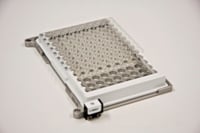
Problem being addressed[edit | edit source]
Infection is a large contributor to maternal mortality and morbidity in developing countries. Nearly one third of all maternal deaths are attributed to infection, which can easily be prevented by minor improvements in sterile child delivery practices and reduction of bacterial transmission. Additionally, improvements in the diagnosis of sepsis can help improve mortality rates as well.
Detailed description of the solution[edit | edit source]
This sepsis identification method uses a new microarray platform that determines the type of bacteria through the use of antibiotics. The "microarray platform is a series of microscopic spots of short DNA fragments whose sequences are specific for individual organisms." Prove-It is highly accurate and produces results faster than the current gold standard by 18 hours, allowing for rapid and effective treatment of the infection. It is able to detect more than 60 species of gram negative and gram positive bacteria that most frequently cause sepsis. Additionally, the test can identify 13 fungal pathogens and antibiotic resistance markers.
Designed by[edit | edit source]
- Designed by: Mobidiag Ltd, Finland, MGRADE (Roche Diagnostics)
- Manufacturer location:
Helsinki, Finland (Distributors throughout Europe and Middle East: http://www.mobidiag.com/Order/LocalDistributors/tabid/183/Default.aspx
When and where it was tested/implemented[edit | edit source]
The device has mainly been tested in laboratory settings, where it is generally expected to be used.
References[edit | edit source]
Peer-reviewed publication[edit | edit source]
Allais, E., Boisset, S. et al (2009). 'Use of a new and simple microarray assay (Prove-itTM Sepsis) for rapid identification of bacteria involved in bone and joint infections directly from clinical samples', Clinical Microbiology and Infection, 15, S279.
Tissari, P., Zumla, A. et al (2010). Accurate and rapid identification of bacterial species from positive blood cultures with a DNA-based microarray platform: an observational study, The Lancet, 375(9710), 224-230.
Yoo, S. M. & Lee, S. Y. (2010). DNA microarray for the identification of pathogens causing bloodstream infections. Expert Rev Mol Diagn, 10(3), 263- 268.
Lehmann, L. E., Hunfeld, K. P. et al (2010). Improved detection of blood stream pathogens by real-time PCR in severe sepsis. Intensive Care Med, 36(1), 49-56.
Peters, Remco PH, Paul HM Savelkoul, and Christina MJE Vandenbroucke-Grauls. (2010). Future Diagnosis of Sepsis. The Lancet, 375(9728), 1779-780.
Other internally generated reports[edit | edit source]
Mobidiag Ltd (2009). Prove-it™ Sepsis. Retrieved Nov 13, 2011, from http://www.mobidiag.com/Products/ProveittradeSepsis/tabid/60/Default.aspx
Externally generated reports[edit | edit source]
EuroScan International Network. (2011, March 4). Rapid Molecular Assays for the Diagnosis of Sepsis and Identification of Sepsis Causing Pathogens. Retrieved November 13, 2011, from http://www.euroscan.org.uk/technologies/technology/ view/1594
IP and copyright[edit | edit source]
Mobidag currently owns a patent on this product.